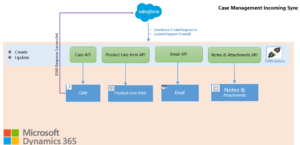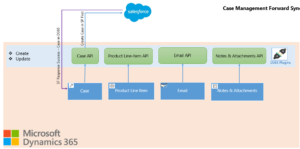Company profile
A large furniture retailer with global presence is headquartered in Arcadia, Wisconsin, and has its distribution centers in Washington, California, New Jersey and Florida in the United States. Their global operations span across Canada, Mexico, Japan, Central America, Japan, and Singapore.
From the first HomeStore in Alaska in 1997 the retail arm grew to become 800+ stores worldwide, and the brand, the #1 home furniture retailer in North America.
The challenge
Customer Service Reps (CSRs) use Dynamics 365 for tracking Sales Order cases. In the absence of data sync, CSR users may face the following issues:
- Not find cases which are created for a particular Sales Order, and difficulties to review and process those cases.
- Not be able to view case details such as product line items related to the case.
- In the absence of data sync users will not get timely updates about the case; which includes updates on details, case notes, e-mails, and case attachments parts order.
- Only when the data is properly synced between D 365 and Salesforce, can the cases be scheduled with a technician, according to the case type, location, and service availability.
The solution
Synch-up data between D 365 and Salesforce for case management entities using APIs
A case represents a single incident of service. In other words, it represents anything in the context of a customer interaction that requires some resolution or an answer. Case management is an activity where we create and update a case either in D 365 or Salesforce (SFDC).
Multiple cases can be associated with a single customer at any time
The cases and their related items are synced between D 365 and Salesforce using the specific API. Each operation performed either in D 365 or SFDC has a separate API call.
Whenever a case or its related items are created or updated in D 365, the corresponding Salesforce API is called from D365 side to sync the create/update operation in Salesforce, and in the same way whenever a create/update operation is triggered on the Salesforce side, the corresponding D365 API is called by Salesforce to sync the operation in D365.
The Benefits
- Data synch is required for D 365 entities like case, product line item, email, case notes, and case attachments.
- Synching data is two-way:
- D 365 calls SFDC APIs and
- SF calls D 365 APIs.
- Create, update operations are performed by APIs.
- For every case there will be a number of product line items such as emails and case notes which are the main factors affecting the case.
- Similarly, we can create and update other custom entities as well including emails, case notes, case attachments, product line items, parts ordering, and technician scheduling.
- Sales Order from customer (account) under one market (store center) is maintained by the Customer Data Platform (CDP) team. The Sales Order contains customer details, payment details, order details, address details, sales details, delivery details, etc.
- Virtual entities allow Dynamics 365 users to utilize and record information from external data sources, view the information in fields, and search results within D 365. In D 365 we have the Sales Order as the virtual entity which receives data from the external system (CDP) and these data are not stored in the database. The API fetches the data in real time and displays it accordingly.
Solution Schema Diagrams.
Incoming Synchronization:

Forward Synchronization:
The result
Whenever any case gets created and updated in D 365 and Salesforce, both can be synchronized into two systems, and we are able to find those incidents.
As a result of data synch, users are able to view and track the case details, product line items, case attachments, emails, case notes, parts order details, technician information, etc.
Next steps:
Similar to Sales Order case entities, other entities like case notes, case attachments and emails can also be synched up between two systems (D 365 & SFDC).












